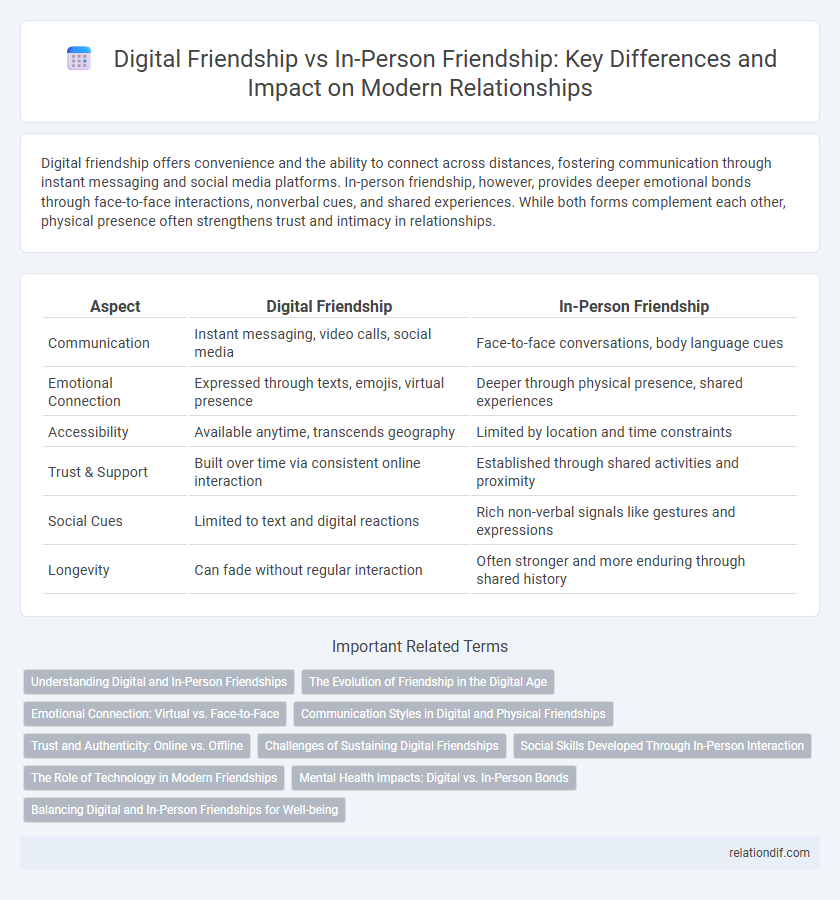Digital friendship offers convenience and the ability to connect across distances, fostering communication through instant messaging and social media platforms. In-person friendship, however, provides deeper emotional bonds through face-to-face interactions, nonverbal cues, and shared experiences. While both forms complement each other, physical presence often strengthens trust and intimacy in relationships.
Table of Comparison
| Aspect | Digital Friendship | In-Person Friendship |
|---|---|---|
| Communication | Instant messaging, video calls, social media | Face-to-face conversations, body language cues |
| Emotional Connection | Expressed through texts, emojis, virtual presence | Deeper through physical presence, shared experiences |
| Accessibility | Available anytime, transcends geography | Limited by location and time constraints |
| Trust & Support | Built over time via consistent online interaction | Established through shared activities and proximity |
| Social Cues | Limited to text and digital reactions | Rich non-verbal signals like gestures and expressions |
| Longevity | Can fade without regular interaction | Often stronger and more enduring through shared history |
Understanding Digital and In-Person Friendships
Digital friendships offer convenient communication across distances, enabling constant connection through social media and messaging platforms, while in-person friendships provide deeper emotional bonding via physical presence and shared activities. Understanding these dynamics reveals that digital interactions can supplement but often lack the non-verbal cues and spontaneous experiences critical to building trust and empathy found in face-to-face relationships. Research shows that combining both digital and in-person interactions enhances relationship quality, fostering comprehensive support systems in modern social networks.
The Evolution of Friendship in the Digital Age
Digital friendship has transformed connection dynamics by enabling instant communication and global reach, yet it often lacks the nuanced emotional depth found in in-person interactions. Advances in social media platforms, messaging apps, and virtual reality have expanded opportunities for maintaining relationships across distances, influencing how trust and intimacy develop. Despite technological benefits, studies indicate that face-to-face interactions continue to foster stronger empathetic bonds and nonverbal cue recognition essential for deep friendship.
Emotional Connection: Virtual vs. Face-to-Face
Emotional connections in digital friendships rely heavily on text-based communication, emojis, and video calls, which can sometimes limit the depth of non-verbal cues and physical presence essential for empathy and trust. In-person friendships benefit from face-to-face interactions that engage multiple senses, fostering stronger emotional bonds through body language, touch, and shared experiences. Research indicates that while digital friendships sustain companionship, face-to-face connections more effectively nurture deeper emotional understanding and support.
Communication Styles in Digital and Physical Friendships
Digital friendships primarily rely on text-based communication, emojis, and multimedia, which may lack nonverbal cues such as body language and tone. In-person friendships benefit from face-to-face interactions, enabling richer emotional expression and immediate feedback through gestures, facial expressions, and vocal intonations. These differences in communication styles influence the depth, empathy, and understanding achievable within each type of friendship.
Trust and Authenticity: Online vs. Offline
Digital friendship often lacks the depth of trust and authenticity found in in-person interactions due to the absence of physical cues and immediate emotional feedback. Trust in online friendships can be fragile, as identity verification is limited and communication is prone to misinterpretation. Authenticity thrives more naturally in offline friendships where consistent face-to-face engagement fosters genuine understanding and emotional connection.
Challenges of Sustaining Digital Friendships
Maintaining digital friendships presents challenges such as limited nonverbal cues, leading to potential misunderstandings and reduced emotional connection. Time zone differences and inconsistent communication patterns disrupt regular interactions, weakening the bond over time. The absence of physical presence often diminishes trust-building opportunities, making digital friendships more vulnerable to drifting apart compared to in-person relationships.
Social Skills Developed Through In-Person Interaction
In-person friendships cultivate essential social skills such as nonverbal communication, empathy, and conflict resolution through face-to-face interactions. Physical presence allows for immediate feedback and deeper emotional connections, enhancing trust and understanding. These experiences foster stronger interpersonal abilities compared to digital friendships, which often lack the richness of real-time social cues.
The Role of Technology in Modern Friendships
Technology transforms modern friendships by enabling constant connectivity through social media, messaging apps, and video calls, bridging geographical distances. Digital platforms foster diverse social networks but can lack the depth of emotional bonding found in face-to-face interactions. Despite these differences, technology enhances friendship maintenance by facilitating shared experiences and timely communication across time zones.
Mental Health Impacts: Digital vs. In-Person Bonds
Digital friendships provide convenience and broad social reach but may lack the emotional depth and nonverbal cues essential for robust mental health support. In-person friendships foster stronger psychological well-being through direct personal interaction, which enhances empathy, reduces feelings of loneliness, and improves stress management. Research indicates that while online connections can supplement social networks, face-to-face bonds are more effective in mitigating anxiety and depression.
Balancing Digital and In-Person Friendships for Well-being
Balancing digital and in-person friendships is crucial for overall well-being, as face-to-face interactions provide emotional depth and nonverbal cues that digital communication often lacks. Research from the American Psychological Association highlights that in-person social engagement significantly reduces stress and promotes mental health. Integrating meaningful online connections with regular physical meetups creates a supportive social network essential for emotional resilience and life satisfaction.
digital friendship vs in-person friendship Infographic

 relationdif.com
relationdif.com